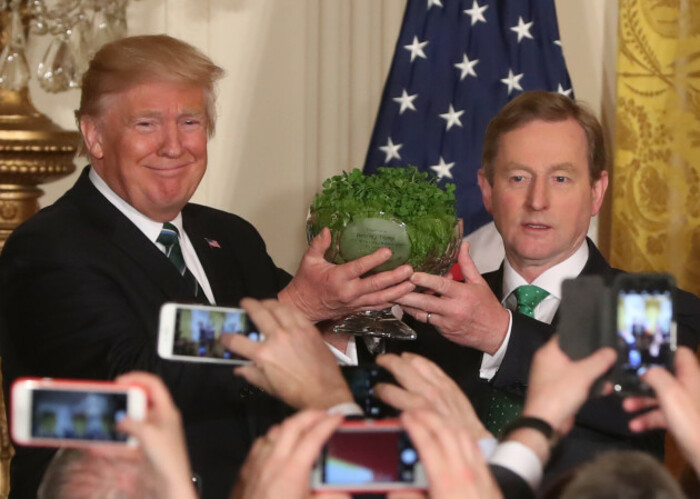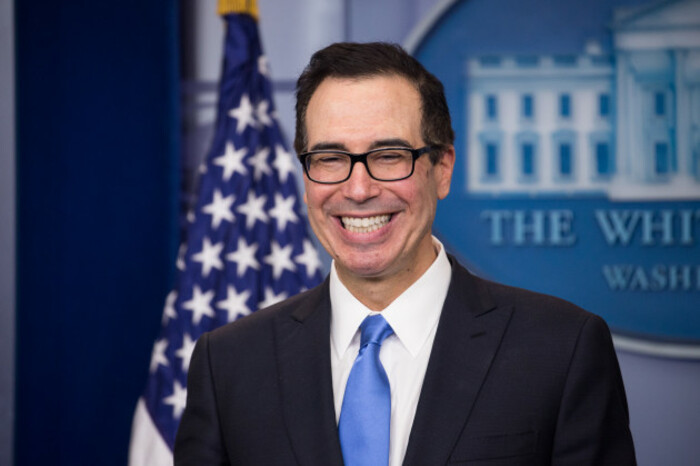Donald Trump is promising 'the biggest tax cut ever' - but it's unlikely he can pay for it
Changes to US company taxes have been highlighted as one of the biggest risks to Ireland.
PRESIDENT DONALD TRUMP plans to stick with his campaign pledge to slash the US corporate tax rate from 35% to 15%, but the dramatic cut raises a problematic question for the White House: How can the president deliver the “massive” tax cut he promised without also blowing a massive hole in the budget?
A senior administration official confirmed the planned reduction to corporate rates, speaking on condition of anonymity in order discuss details of the plan the president is expected to unveil this week.
Trump’s plans for “a very large border tax”, coupled with a dramatic cut in the corporate tax, have been highlighted by local analysts as one of the biggest economic risks to Ireland.
Both moves could stifle the flow of American investment into Ireland by making it more attractive for US firms to spend money on their domestic operations instead.
However most outside economic analyses say the type of tax cuts being promoted by Trump would likely fuel even larger deficits for a federal government already projected to see its debt steadily rise.
They are also unlikely to generate Trump’s ambitious promised growth rate of 3% a year, roughly double the 1.6% growth achieved last year.
These two factors are related because the Trump administration is counting on faster economic growth to produce additional tax revenues that could then close the deficit. The concept has been popularised as “trickle-down” economics. The problem is that the economy can’t grow quickly enough to cover the likely hole in the deficit.
“There’s no pure tax cut that pays for itself,” said Alan Cole, an economist at the right-leaning Tax Foundation.
Trump has promised to release the outlines of his tax plan tomorrow and has said the plan would give Americans a tax cut bigger than “any tax cut ever”. During the campaign, he backed cutting the corporate tax rate and the personal income tax rate to 33% from a top marginal rate of 39.6%.
 Donald Trump and Enda Kenny
Donald Trump and Enda Kenny
Paying for itself
Although he did not disclose details, US treasury secretary Steven Mnuchin said yesterday the lower tax rates would generate so much economic growth that it would hold the deficit in check.
“The tax reform will pay for itself with economic growth,” Mnuchin said at the White House news briefing, adding that the overhaul would ideally let someone file taxes on a “large postcard”.
By running the risk of higher deficits, the Trump plan could damage the credibility of Republican lawmakers who spent years railing against the rising national debt under former President Barack Obama.
Trump could also make it harder to pass lasting tax reform, since any policy that increases the debt above its baseline either requires Democratic support or — if passed by a slim majority of Republicans in the Senate — would expire in a decade.
The House Republican tax blueprint tried to offset the lower rates by introducing a new tax system that applies to imports.
Mnuchin and White House economic adviser Gary Cohn are scheduled to meet with congressional leaders this evening to talk about the president’s tax plan.
In a briefing note this morning, Goodbody chief economist Dermot O’Leary said US tax reforms remained a risk to Ireland, “but the legislative hurdles appear to be higher than previously thought”.
 US treasury secretary Steven Mnuchin
US treasury secretary Steven Mnuchin
Border tax doubts
Without a proposal on the table, the White House has been vague about the president’s support for ideas circulating in Congress.
It’s unclear whether the president favors a border adjustment tax system, which would lower corporate rates to 20% by essentially taxing imports and excluding US exports.
Trump told Fox Business News that he prefers a “reciprocal” tax in which any tariffs, duties or taxes would match what trading partners charge.
Most economists say it’s unlikely that tax cuts can generate enough gains to prevent the budget deficit — estimated to total $559 billion this year — from rising.
They also have recent real-world examples to make their case: Tax cuts in Kansas failed to deliver the expected boost, forcing the state into years of gruelling budget battles and harsh spending cuts to make up the gap.
The benefits of the tax cuts could also be limited by economic forces beyond Trump’s immediate control.
The Federal Reserve could raise short-term interest rates, investors might charge the government higher borrowing costs and a stronger dollar could temper growth through exports, said Mark Doms, a senior economist at the bank Nomura.
“Doing some kind of tax cut might boost growth a bit, but there are forces that would counteract the tax cut,” Doms said.
Tax reform would likely have a modest effect on growth, almost surely not enough to match the administration’s 3% growth target, said Mark Mazur, director of the nonpartisan Tax Policy Center and a former assistant treasury secretary for tax policy in the Obama administration.
Major tax cuts might also provide a short-term boost, but they would likely produce additional debt that would dampen growth in the future.
“The laws of arithmetic kind of catch up to you,” Mazur said.
Additional reporting Peter Bodkin
Sign up to our newsletter to receive a regular digest of Fora’s top articles delivered to your inbox.






